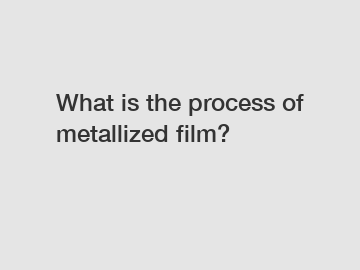What is the process of metallized film?
What is the process of metallized film?
Metallized film is a type of flexible packaging material that has been coated with a thin layer of metal, typically aluminum. This process is used to enhance the barrier properties, appearance, and even conductivity of the film, making it suitable for various applications in industries such as food and beverage, pharmaceuticals, and electronics.
Metallizing film involves several critical steps, each contributing to the overall quality and functionality of the final product. Let's explore the metallization process in detail:

1. Substrate preparation:
Before metallization can take place, the film substrate must go through a series of preparations. This typically involves cleaning the film to remove any dirt, dust, or impurities that may affect the adhesion of the metal layer. The film may also undergo corona treatment, which enhances the surface energy of the substrate and promotes better metal adhesion.
2. Vacuum chamber:
The next step is to place the prepared film into a vacuum chamber. The vacuum chamber is a controlled environment where the metallization process takes place. The chamber is typically made of stainless steel and designed to maintain a specific pressure and temperature throughout the process.
3. Vaporization:
During metallization, a thin layer of metal is deposited onto the film substrate in the form of vapor. The metal, usually aluminum, is loaded into a crucible or coil within the vacuum chamber. Once the chamber reaches the desired pressure and temperature, the metal is heated until it vaporizes. The metal vapor then condenses onto the film surface, forming a thin, uniform layer.
4. Plasma treatment:
To further enhance the adhesion and quality of the metal layer, a plasma treatment may be applied. Plasma treatment involves exposing the film to a high-frequency electric field, creating a plasma glow. This treatment can help remove any remaining impurities on the film surface, making it more receptive to the metal coating.
5. Cooling and winding:
After the metal has been deposited onto the film, the next step is to cool the substrate and solidify the metal layer. Cooling is essential to stabilize the metallized film and prevent any damage or distortion. Once cooled, the metallized film is wound onto rolls for further processing or packaging.
Metallized films offer several advantages over traditional packaging materials. They exhibit excellent barrier properties, providing protection against moisture, oxygen, and UV rays. Additionally, the metal layer can enhance the film's appearance, giving it a shiny and reflective surface that creates an eye-catching effect. The conductivity of metallized films also makes them ideal for applications in the electronics industry, where static control is crucial.
In conclusion, the metallization process plays a vital role in transforming ordinary film substrates into high-performance packaging materials. By depositing a thin layer of metal onto the film surface, metallized films offer enhanced barrier properties, improved aesthetics, and conductivity. This versatile packaging solution finds applications in various industries, ranging from food and beverage to electronics. If you're interested in utilizing metallized films for your packaging needs, don't hesitate to contact us for expert advice and assistance.
Contact us now to learn more about metallized films and their applications in packaging.
Contact us to discuss your requirements of silicone coated pet release film, metallized oriented polypropylene characteristics, bopp film manufacturers. Our experienced sales team can help you identify the options that best suit your needs.


